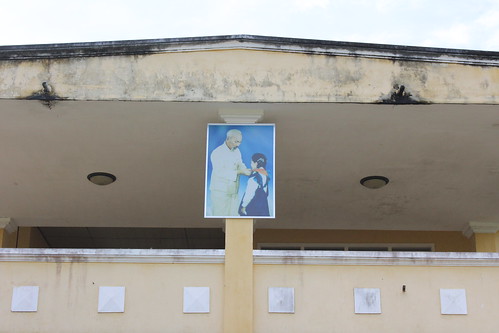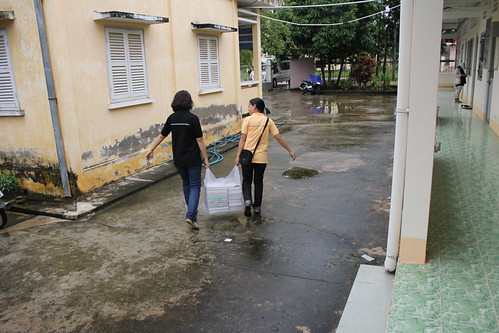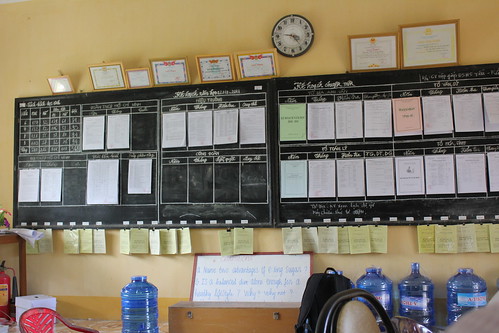Elsewhere in Vietnam, bursting emerald fields of maturing rice neatly fill the landscape, but in Tra Cu the rice is sparse because farmers harvest early and often, ignoring the long-term damage to their fields for day-to-day survival. Tra Cu is the poorest district in Tra Vinh province. Its primary industry is agriculture, but poor soil conditions and declining rice prices mean that those with land can barely get by, and those without must become migrant workers elsewhere. Due to the need for income and a lack of societal emphasis on education, many girls are encouraged to start working very early, resulting in one of the highest dropout rates for girls in the country. No surprise, then, that this was the place Room to Read chose for a Girls Education Program (GEP) pilot here.
(Picture version of this story here)
The main goal of the GEP is to help girls to stay enrolled until at least finishing high school; the broader goal is to individually empower girls while also educating communities about the importance of girls' education and rights. To accomplish this, GEP provides girls with three types of support: material (school fees, bicycles, uniforms, textbooks), academic (tutoring, progress monitoring by social mobilizers), and social (life skills training, meetings to educate families and communities about girls' rights). In Ho Chi Minh City, RtR Vietnam's first site for a GEP, the program graduated its first batch of students last year: of the 38 girls, 8 got into university, an impressive feat considering their disadvantaged backgrounds and the average acceptance rate of 1 in 20!

Popular image of Ho Chi Minh honoring a female student, Long Hiep Secondary School
RtR Vietnam's strategy in Tra Cu is a new experiment; in Ho Chi Minh City, girls were enrolled into the program on an individual basis, but in Tra Cu RtR has decided to enroll all girls with demonstrated need (345 out of 506, a staggering percentage) at three secondary schools in Tra Cu. Once involved with a school, Room to Read stays until the first batch of girls graduates--at least 7 years. RtR hopes that this approach will create uplifting changes at the community level. To get a sense of how this is going, we visited with the Tra Cu Department of Education, the teachers at Long Hiep secondary school, and the families of 4 girls currently enrolled in the program.
Room to Read works very closely with Tra Cu's Department of Education--so much so that 2 Room to Read staffers actually have offices within the Department's facilities! This intimacy is really a necessity for RtR to implement its projects successfully, as the Department has total control over the operations of the schools. The collaboration is closely monitored from both sides--the Memorandum of Understanding which details the working relationship is evaluated and updated every year after a careful assessment of progress.

Two Room to Read staffers carry books for delivery to the schools from the field office in Tra Cu
From the government's perspective, Room to Read's work helps them without placing any extra financial burden on them. When asked about the reception of the project within the community, they agreed that even if parents (or school administrators) didn't understand the deeper goals of GEP, they were grateful for the material support, which reduces the burden on them and, in turn, the likelihood that they'll pull their girls out of school. The only negative response, they say, is from parents who feel it is unfair for their boys to not have access to these programs as well.
Next, we met with the director and several social mobilizers/teachers from Long Hiep secondary school, where the GEP has been in place for just more than a year now. Unlike in Laos, the 6 social mobilizers working in Tra Cu are actually teachers selected from the school. The RtR is still figuring out whether this is a sustainable practice. As SMs, the teachers are responsible for teaching life skills training classes on weekends, mentoring the girls one-on-one, serving as their point of contact for emergencies, and visiting students' homes if they are absent for more than 2 days. The teachers agreed that all of these additional responsibilities on top of an already busy teaching schedule is hard to manage, especially since they only a receive a small additional stipend as controlled by the government for these services. On the other hand, they also say that the training they have received is useful in their regular classes as well as in the mentoring sessions, thereby also benefiting students outside of the GEP. Additionally, the ambient presence of the teachers during school hours can be useful both for students seeking advice or for observing the students' progress in a normal social setting.

The staff room at Long Hiep Secondary School
The director explained that the biggest challenge for the school is crowding: with only 7 classrooms for 14 classes, scheduling was already difficult without the GEP's additional needs. As a result, many GEP classes happen on weekends, creating an additional burden for teachers and students alike. However, early results seem to indicate that the program is making a difference: the dropout rate of girls is already decreasing, and parents have even been attending school meetings more frequently since Room to Read's involvement.
In the next post, we'll take you to the houses of the girls involved in the program and see what they have to say. Stay tuned!
(Sorry about the delay in updates, everyone! Good wifi and leftover energy are both hard to find when zooming from place to place. But now that my official adventures are over, expect more regular postings!)

